Analysis of the Microclimatic and Biodiversity-Enhancing Functions of a Living Wall Prototype for More-than-Human Conviviality in Cities
Abstract
:1. Introduction
2. Materials and Methods
2.1. Analytical Framework: Differentiation of “Gray”, “Green”, and “Revolutionary” Infrastructure
2.2. Social Science Perspective
2.3. Engineering Studies Perspective and Case Study
2.4. Interdisciplinary Discussion
3. Results
3.1. Characterization of Semi-Natural and Urban Environments and Functions
- Increased surfaces and heat storage mass due to roads and building envelopes
- The change in surface characteristics due to a lower surface albedo
- Outgoing long-wave radiation from the surfaces
- Lower transpiration and evaporation of the surfaces
- Additional anthropogenic heat sources.
3.2. Case Study of the UNA TERRA Living Wall
3.2.1. Concept
3.2.2. Microclimatic Functions
3.2.3. Biodiversity-Enhancing Functions
3.2.4. Summary
4. Discussion
4.1. Rethinking the Nature of Cities
4.2. Green Façade Systems as Gray Infrastructure
4.3. Green Façade Systems as Green Infrastructure
4.4. Green Façade Systems as Revolutionary Infrastructure
5. Conclusions
Author Contributions
Funding
Data Availability Statement
Conflicts of Interest
References
- Haase, D. Grüne Stadt. In Handbuch Stadtkonzepte; Rink, D., Haase, A., Eds.; Verlag Barbara Budrich: Opladen, Germany, 2018; pp. 151–168. [Google Scholar]
- Wong, N.H.; Tan, C.L.; Kolokotsa, D.D.; Takebayashi, H. Greenery as a mitigation and adaptation strategy to urban heat. Nat. Rev. Earth Environ. 2021, 2, 166–181. [Google Scholar] [CrossRef]
- Hummel, D.; Jahn, T.; Kramm, J.; Stieß, I. Gesellschaftliche Naturverhältnisse—Grundbegriff und Denkraum für die Gestaltung von sozial-ökologischen Transformationen. In Handbuch, Umweltsoziologie; Sonnberger, M., Bleicher, A., Groß, M., Eds.; Springer Fachmedien Wiesbaden: Wiesbaden, Germany, 2023; pp. 1–15. [Google Scholar] [CrossRef]
- Hölscher, K.; Frantzeskaki, N. Perspectives on urban transformation research: Transformations in, of, and by cities. Urban Transform. 2021, 3, 2. [Google Scholar] [CrossRef]
- Kabisch, S.; Koch, F.; Gawel, E.; Haase, A.; Knapp, S.; Krellenberg, K.; Zehnsdorf, A. Urban Transformations. Sustainable Urban Development through Resource Efficiency, Quality of Life and Resilience; Springer: Cham, Switzerland, 2018. [Google Scholar]
- Bulkeley, H. Cities and Climate Change; Routledge: Abingdon, UK, 2013. [Google Scholar]
- IPCC. Synthesis Report of the IPCC Sixth Assessment Report (AR6). Longer Report. 2023. Available online: https://www.ipcc.ch/report/sixth-assessment-report-cycle/ (accessed on 16 May 2023).
- United Nations Human Settlements Programme (UN-Habitat). Global Report on Human Settlements 2011: Cities and Climate Change. 2011. Available online: https://unhabitat.org/global-report-on-human-settlements-2011-cities-and-climate-change (accessed on 16 May 2023).
- Angel, S.; Blei, A.M.; Parent, J.; Lamson-Hall, P.; Galarza-Sanchez, N.; Civco, D.L.; Thom, K. The New Urban Peripheries, 1990–2014: Selected Findings from a Global Sample of Cities. 2018. Available online: https://marroninstitute.nyu.edu/papers/the-new-urban-peripheries-1990-2014 (accessed on 16 May 2023).
- Seto, K.C.; Güneralp, B.; Hutyra, L.R. Global forecasts of urban expansion to 2030 and direct impacts on biodiversity and carbon pools. Proc. Natl. Acad. Sci. USA 2012, 109, 16083–16088. [Google Scholar] [CrossRef] [PubMed]
- United Nations Department of Economic and Social Affairs. World Urbanization Prospects: The 2018 Revision; United Nations: New York, NY, USA, 2019. [Google Scholar] [CrossRef]
- Grimm, N.B.; Faeth, S.H.; Golubiewski, N.E.; Redman, C.L.; Wu, J.; Bai, X.; Briggs, J.M. Global Change and the Ecology of Cities. Science 2008, 319, 756–760. [Google Scholar] [CrossRef]
- Tratalos, J.; Fuller, R.A.; Warren, P.H.; Davies, R.G.; Gaston, K.J. Urban form, biodiversity potential and ecosystem services. Landsc. Urban Plan. 2007, 83, 308–317. [Google Scholar] [CrossRef]
- Masson, V.; Lemonsu, A.; Hidalgo, J.; Voogt, J. Urban Climates and Climate Change. Annu. Rev. Environ. Resour. 2020, 45, 411–444. [Google Scholar] [CrossRef]
- Oke, T.R. The energetic basis of the urban heat island. Q. J. R. Meteorol. Soc. 1982, 108, 1–24. [Google Scholar] [CrossRef]
- Oke, T.R.; Mills, G.; Christen, A.; Voogt, J.A. Urban Heat Island. In Urban Climates; Cambridge University Press: Cambridge, UK, 2017; pp. 197–237. [Google Scholar] [CrossRef]
- Soga, M.; Yamaura, Y.; Koike, S.; Gaston, K.J. Land sharing vs. land sparing: Does the compact city reconcile urban development and biodiversity conservation? J. Appl. Ecol. 2014, 51, 1378–1386. [Google Scholar] [CrossRef]
- Strohbach, M.W.; Haase, D.; Kabisch, N. Birds and the City: Urban Biodiversity, Land Use, and Socioeconomics. Ecol. Soc. 2009, 14, 31. [Google Scholar] [CrossRef]
- Sushinsky, J.R.; Rhodes, J.R.; Possingham, H.P.; Gill, T.K.; Fuller, R.A. How should we grow cities to minimize their biodiversity impacts? Glob. Chang. Biol. 2012, 19, 401–410. [Google Scholar] [CrossRef]
- Brenner, N. Implosions/Explosions: Towards a Study of Planetary Urbanization; JOVIS Verlag GmbH: Berlin, Germany, 2015. [Google Scholar]
- Brenner, N.; Schmid, C. The ‘Urban Age’ in Question. Int. J. Urban Reg. Res. 2013, 38, 731–755. [Google Scholar] [CrossRef]
- Brenner, N.; Schmid, C. Towards a new epistemology of the urban? City 2015, 19, 151–182. [Google Scholar] [CrossRef]
- German Advisory Council on Global Change (WBGU). Humanity on the Move. Unlocking the Transformative Power of Cities. Summary. Berlin: WBGU. 2016. Available online: https://www.wbgu.de/en/publications/publication/humanity-on-the-move-unlocking-the-transformative-power-of-cities#section-downloads (accessed on 16 May 2023).
- Boyer, D. Revolutionary Infrastructure. In Infrastructures and Social Complexity; Harvey, P., Jensen, C., Morita, A., Eds.; Routledge: London, UK, 2016; pp. 174–186. [Google Scholar]
- Boyer, D. Infrastructure, Potential Energy, Revolution. In The Promise of Infrastructure; Anand, N., Appel, H., Gupta, A., Eds.; Duke University Press: Durham, UK, 2018; pp. 223–243. [Google Scholar]
- Boyer, D. Infrastructural Futures in the Ecological Emergency: Gray, Green, and Revolutionary. Hist. Soc. Res. Hist. Soz. 2022, 47, 48–65. [Google Scholar] [CrossRef]
- Graham, S.; Marvin, S. Splintering Urbanism; Routledge: London, UK, 2001. [Google Scholar] [CrossRef]
- Houston, D.; Hillier, J.; MacCallum, D.; Steele, W.; Byrne, J. Make kin, not cities! Multispecies entanglements and ‘becoming-world’ in planning theory. Plan. Theory 2017, 17, 190–212. [Google Scholar] [CrossRef]
- Larkin, B. The Politics and Poetics of Infrastructure. Annu. Rev. Anthr. 2013, 42, 327–343. [Google Scholar] [CrossRef]
- Davidová, M. Breathing Artifacts of Urban BioClimatic Layers for Post-Anthropocene Urban Environment. Sustainability 2021, 13, 11307. [Google Scholar] [CrossRef]
- Krause, P.; Meier, L.; Leistner, P.; Eitle, A.; Bender, E.; Fischer, L.K.; Müller, H. Entwicklung und Erprobung eines urbanen Grünfassadensystems für Mensch, Flora und Fauna. Bauphysik 2023, 45, 44–54. [Google Scholar] [CrossRef]
- Kropp, C. Stadt und Natur: Urbane Assemblagen und ihre Transformation. In Handbuch Umweltsoziologie; Sonnberger, M., Bleicher, A., Groß, M., Eds.; Springer: Wiesbaden, Germany, 2023. [Google Scholar] [CrossRef]
- Arora, S.; Van Dyck, B.; Sharma, D.; Stirling, A. Control, care, and conviviality in the politics of technology for sustainability. Sustain. Sci. Pract. Policy 2020, 16, 247–262. [Google Scholar] [CrossRef]
- Hinchliffe, S.; Whatmore, S. Living cities: Towards a politics of conviviality. Sci. Cult. 2006, 15, 123–138. [Google Scholar] [CrossRef]
- Fetting, C. The European Green Deal. ESDN Report. 2020. Available online: https://www.esdn.eu/publications/esdn-reports (accessed on 16 May 2023).
- European Commission. Nature-Based Solutions Research Policy. 2022. Available online: https://research-and-innovation.ec.europa.eu/research-area/environment/nature-based-solutions/research-policy_en (accessed on 2 May 2023).
- Star, S.L. The Ethnography of Infrastructure. Am. Behav. Sci. 1999, 43, 377–391. [Google Scholar] [CrossRef]
- Farías, I. Introduction. Decentring the object of urban studies. In Urban Assemblages. How Actor-Network Theory Changes Urban Studies; Farías, I., Bender, T., Eds.; Routledge: London, UK, 2012; pp. 1–24. [Google Scholar]
- IPCC. Climate Change 2022: Impacts, Adaptation and Vulnerability; Cambridge University Press: Cambridge, UK, 2022. [Google Scholar] [CrossRef]
- Beck, S.; Jasanoff, S.; Stirling, A.; Polzin, C. The governance of sociotechnical transformations to sustainability. Curr. Opin. Environ. Sustain. 2021, 49, 143–152. [Google Scholar] [CrossRef]
- Edwards, P.N. Infrastructure and Modernity: Force, Time, and Social Organization in the History of Sociotechnical Systems. In Modernity and Technology; Misa, T.J., Brey, P., Feenberg, A., Eds.; The MIT Press: Cambridge, MA, USA, 2003; pp. 185–225. [Google Scholar] [CrossRef]
- Haraway, D. Simians, Cyborgs, and Women. The Reinvention of Nature; Routledge: New York, NY, USA, 1990. [Google Scholar] [CrossRef]
- Latour, B. The Pasteurization of France; Harvard University Press: Cambridge, MA, USA, 1988. [Google Scholar]
- Latour, B. We Have Never Been Modern; Harvard University Press: Cambridge, MA, USA, 1993. [Google Scholar]
- Farías, I.; Bender, T. Urban Assemblages. How Actor-Network Theory Changes Urban Studies; Routledge: London, UK, 2010. [Google Scholar]
- Kurath, M.; Marskamp, M.; Paulos, J.; Ruegg, J. Relational Planning. Tracing Artefacts, Agency and Practices; Springer International Publishing: Cham, Switzerland, 2018. [Google Scholar]
- Swyngedouw, E. The city as a hybrid: On nature, society and cyborg urbanization. Capital. Nat. Social. 1996, 7, 65–80. [Google Scholar] [CrossRef]
- Wachsmuth, D. Three Ecologies: Urban Metabolism and the Society-Nature Opposition. Sociol. Q. 2012, 53, 506–523. [Google Scholar] [CrossRef]
- Winter, K. Ansichtssache Stadtnatur: Zwischennutzungen und Naturverständnisse; Transcript: Bielefeld, Germany, 2015. [Google Scholar]
- Yaneva, A.; Zaera-Polo, A. What Is Cosmopolitical Design? Design, Nature and the Built Environment; Routledge: London, UK, 2015. [Google Scholar]
- Angelo, H.; Wachsmuth, D. Urbanizing Urban Political Ecology: A Critique of Methodological Cityism. Int. J. Urban Reg. Res. 2014, 39, 16–27. [Google Scholar] [CrossRef]
- Harvey, D. Justice, Nature and the Geography of Difference; Wiley-Blackwell: Cambridge, MA, USA, 1996. [Google Scholar]
- Heynen, N.; Kaika, M.; Swyngedouw, E. the Nature of Cities: Urban Political Ecology and the Politics of Urban Metabolism; Routledge: London, UK, 2006. [Google Scholar]
- Swyngedouw, E.; Heynen, N.C. Urban Political Ecology, Justice and the Politics of Scale. Antipode 2003, 35, 898–918. [Google Scholar] [CrossRef]
- McFarlane, C. The geographies of urban density. Prog. Hum. Geogr. 2015, 40, 629–648. [Google Scholar] [CrossRef]
- McFarlane, C. De/re-densification. City 2020, 24, 314–324. [Google Scholar] [CrossRef]
- Franklin, A. The more-than-human city. Sociol. Rev. 2017, 65, 202–217. [Google Scholar] [CrossRef]
- Haraway, D.J. Staying with the Trouble; Duke University Press: Durham, UK, 2016. [Google Scholar] [CrossRef]
- Kallis, G.; Paulson, S.; D′Alisa, G.; Demaria, F. The Case for Degrowth; Polity Press: Cambridge, UK, 2020. [Google Scholar]
- Latour, B. Down to Earth: Politics in the New Climatic Regime; Polity Press: Cambridge, UK, 2018. [Google Scholar]
- McFarlane, C. Assemblage and critical urbanism. City 2011, 15, 204–224. [Google Scholar] [CrossRef]
- Hinchliffe, S.; Kearnes, M.B.; Degen, M.; Whatmore, S. Urban Wild Things: A Cosmopolitical Experiment. Environ. Plan. D Soc. Space 2005, 23, 643–658. [Google Scholar] [CrossRef]
- Metzger, J. The city is not a Menschenpark: Rethinking the tragedy of the urban commons beyond the human/non-human divide. In Urban Commons. Rethinking the City; Borch, C., Kornberger, M., Eds.; Routledge: London, UK, 2015; pp. 22–46. [Google Scholar] [CrossRef]
- Wright, K. An Ethics of Entanglement for the Anthropocene. Scan 2014, 11. Available online: http://scan.net.au/scn/journal/vol11number1/Kate-Wright.html (accessed on 16 May 2023).
- University of Stuttgart. Recorded Measurement Data from the Lauchäcker Weather Station (2022); Department of Hydrology and Geohydrology, Institute for Modelling Hydraulic and Environmental Systems (IWS), University of Stuttgart: Stuttgart, Germany, 2022. [Google Scholar]
- De Frenne, P.; Lenoir, J.; Luoto, M.; Scheffers, B.R.; Zellweger, F.; Aalto, J.; Ashcroft, M.B.; Christiansen, D.M.; Decocq, G.; De Pauw, K.; et al. Forest microclimates and climate change: Importance, drivers and future research agenda. Glob. Chang. Biol. 2021, 27, 2279–2297. [Google Scholar] [CrossRef] [PubMed]
- Halaj, J.; Ross, D.W.; Moldenke, A.R. Importance of habitat structure to the arthropod food-web in Douglas-fir canopies. Oikos 2000, 90, 139–152. [Google Scholar] [CrossRef]
- Ishii, H.T.; Tanabe, S.-I.; Hiura, T. Exploring the Relationships Among Canopy Structure, Stand Productivity, and Biodiversity of Temperate Forest Ecosystems. For. Sci. 2004, 50, 342–355. [Google Scholar] [CrossRef]
- Oliver, T.; Roy, D.; Hill, J.K.; Brereton, T.; Thomas, C. Heterogeneous landscapes promote population stability. Ecol. Lett. 2010, 13, 473–484. [Google Scholar] [CrossRef]
- Tinya, F.; Kovács, B.; Bidló, A.; Dima, B.; Király, I.; Kutszegi, G.; Lakatos, F.; Mag, Z.; Márialigeti, S.; Nascimbene, J.; et al. Environmental drivers of forest biodiversity in temperate mixed forests—A multi-taxon approach. Sci. Total Environ. 2021, 795, 148720. [Google Scholar] [CrossRef]
- Stein, A.; Gerstner, K.; Kreft, H. Environmental heterogeneity as a universal driver of species richness across taxa, biomes and spatial scales. Ecol. Lett. 2014, 17, 866–880. [Google Scholar] [CrossRef]
- Yang, Z.; Liu, X.; Zhou, M.; Ai, D.; Wang, G.; Wang, Y.; Chu, C.; Lundholm, J.T. The effect of environmental heterogeneity on species richness depends on community position along the environmental gradient. Sci. Rep. 2015, 5, 15723. [Google Scholar] [CrossRef]
- Chen, J.; Saunders, S.C.; Crow, T.R.; Naiman, R.J.; Brosofske, K.D.; Mroz, G.D.; Brookshire, B.L.; Franklin, J.F. Microclimate in Forest Ecosystem and Landscape Ecology. Bioscience 1999, 49, 288–297. [Google Scholar] [CrossRef]
- Haesen, S.; Lembrechts, J.J.; De Frenne, P.; Lenoir, J.; Aalto, J.; Ashcroft, M.B.; Kopecký, M.; Luoto, M.; Maclean, I.; Nijs, I.; et al. ForestTemp—Sub-canopy microclimate temperatures of European forests. Glob. Chang. Biol. 2021, 27, 6307–6319. [Google Scholar] [CrossRef]
- Spicer, M.E.; Mellor, H.; Carson, W.P. Seeing beyond the trees: A comparison of tropical and temperate plant growth forms and their vertical distribution. Ecology 2020, 101, e02974. [Google Scholar] [CrossRef] [PubMed]
- de Almeida, C.R.; Teodoro, A.C.; Gonçalves, A. Study of the Urban Heat Island (UHI) Using Remote Sensing Data/Techniques: A Systematic Review. Environments 2021, 8, 105. [Google Scholar] [CrossRef]
- Charoenkit, S.; Yiemwattana, S. Living walls and their contribution to improved thermal comfort and carbon emission reduction: A review. Build. Environ. 2016, 105, 82–94. [Google Scholar] [CrossRef]
- Hunter, A.M.; Williams, N.S.; Rayner, J.P.; Aye, L.; Hes, D.; Livesley, S.J. Quantifying the thermal performance of green façades: A critical review. Ecol. Eng. 2014, 63, 102–113. [Google Scholar] [CrossRef]
- Koch, K.; Ysebaert, T.; Denys, S.; Samson, R. Urban heat stress mitigation potential of green walls: A review. Urban For. Urban Green. 2020, 55, 126843. [Google Scholar] [CrossRef]
- Radić, M.; Dodig, M.B.; Auer, T. Green Facades and Living Walls—A Review Establishing the Classification of Construction Types and Mapping the Benefits. Sustainability 2019, 11, 4579. [Google Scholar] [CrossRef]
- Convertino, F. Heat transfer Modelling in Green Facades. Urban Agric. City Sustain. II WIT Trans. Ecol. Environ. 2020, 243, 57–68. [Google Scholar] [CrossRef]
- Madre, F.; Clergeau, P.; Machon, N.; Vergnes, A. Building biodiversity: Vegetated façades as habitats for spider and beetle assemblages. Glob. Ecol. Conserv. 2015, 3, 222–233. [Google Scholar] [CrossRef]
- Mayrand, F.; Clergeau, P. Green Roofs and Green Walls for Biodiversity Conservation: A Contribution to Urban Connectivity? Sustainability 2018, 10, 985. [Google Scholar] [CrossRef]
- Chen, C.; Mao, L.; Qiu, Y.; Cui, J.; Wang, Y. Walls offer potential to improve urban biodiversity. Sci. Rep. 2020, 10, 9905. [Google Scholar] [CrossRef]
- Mayrand, F.; Clergeau, P.; Vergnes, A.; Madre, F. Vertical Greening Systems as Habitat for Biodiversity. In Nature Based Strategies for Urban and Building Sustainability; Pérez, G., Perini, K., Eds.; Elsevier: Oxford, UK, 2018; pp. 227–237. [Google Scholar] [CrossRef]
- Rose, D.B. Cosmopolitics: The Kiss of Life. New Form. 2012, 76, 101–113. [Google Scholar] [CrossRef]
- Metzger, J. Can the Craft of Planning Be Ecologized? (And Why the Answer to That Question Doesn’t Include ‘Ecosystem Services’). In Relational Planning: Tracing Artefacts, Agency and Practices; Kurath, M., Marskamp, M., Paulos, J., Ruegg, J., Eds.; Springer International Publishing: Cham, Switzerland, 2018; pp. 99–120. [Google Scholar] [CrossRef]
- Umweltbundesamt. Entscheidungshilfen zur Verringerung des Biozideinsatzes an Fassaden. 2019. Available online: https://www.umweltbundesamt.de/sites/default/files/medien/378/dokumente/merkblaetter_1-5_entscheidungshilfen_zur_verringerung_des_biozideinsatzes_an_fassaden.pdf (accessed on 16 May 2023).
- Verband der deutschen Lack- und Druckfarbenindustrie e. V. (VdL). Fachlexikon Putze und Beschichtungen. 2019. Available online: https://www.putz.de/fachlexikon-putze-und-beschichtungen (accessed on 16 May 2023).
- Morton, T.; Boyer, D. Hyposubjects: On Becoming Human; Open Humanities Press: London, UK, 2021; Available online: https://library.oapen.org/handle/20.500.12657/47514 (accessed on 16 May 2023).
- Kropp, C. Urban Gardening. Grüne Nischen Als Strukturwandel von Unten. In Kursbuch 197. Das Grün; Nassehi, A., Felixberger, P., Eds.; Kursbuch: Hamburg, Germany, 2019; pp. 79–94. [Google Scholar]
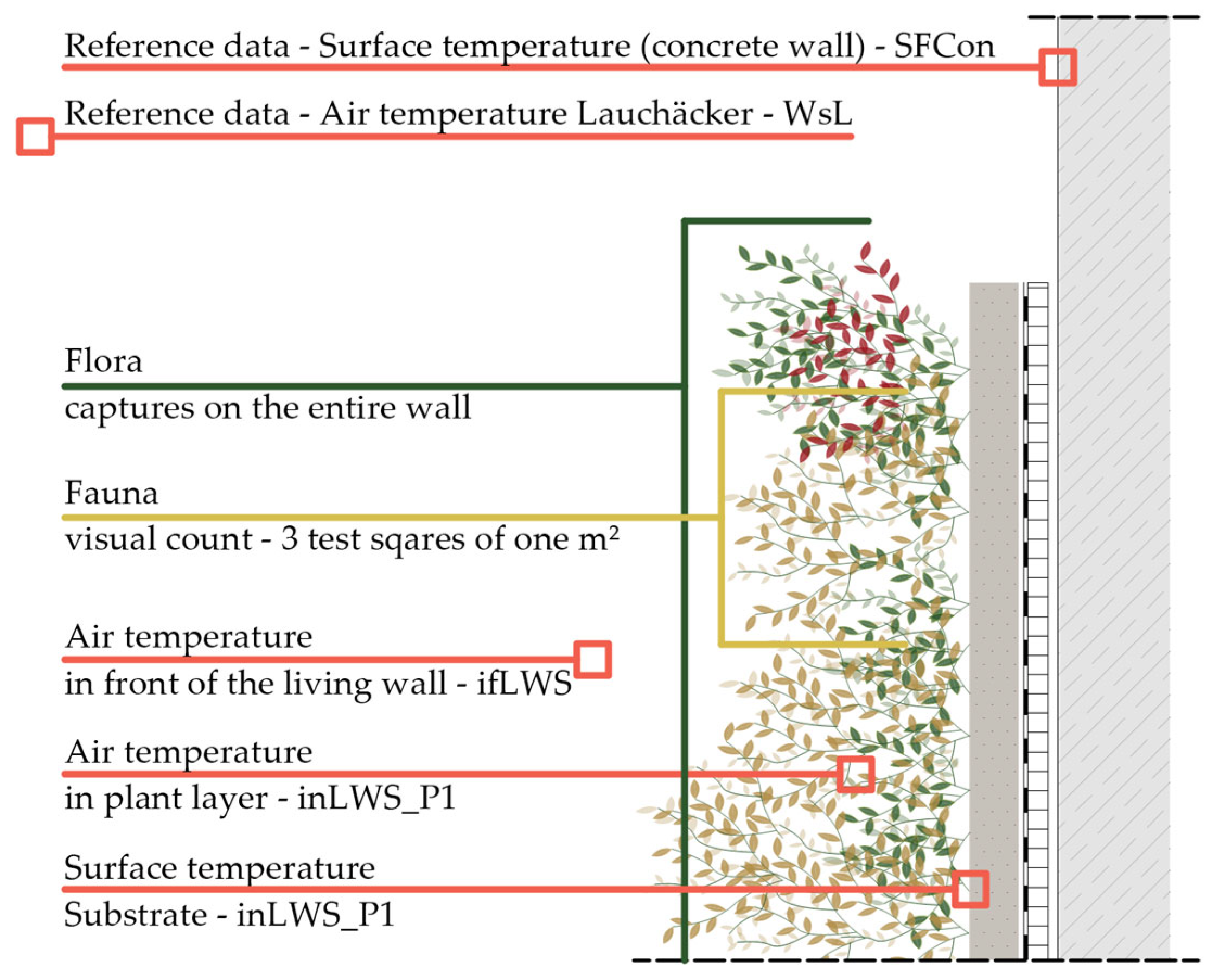

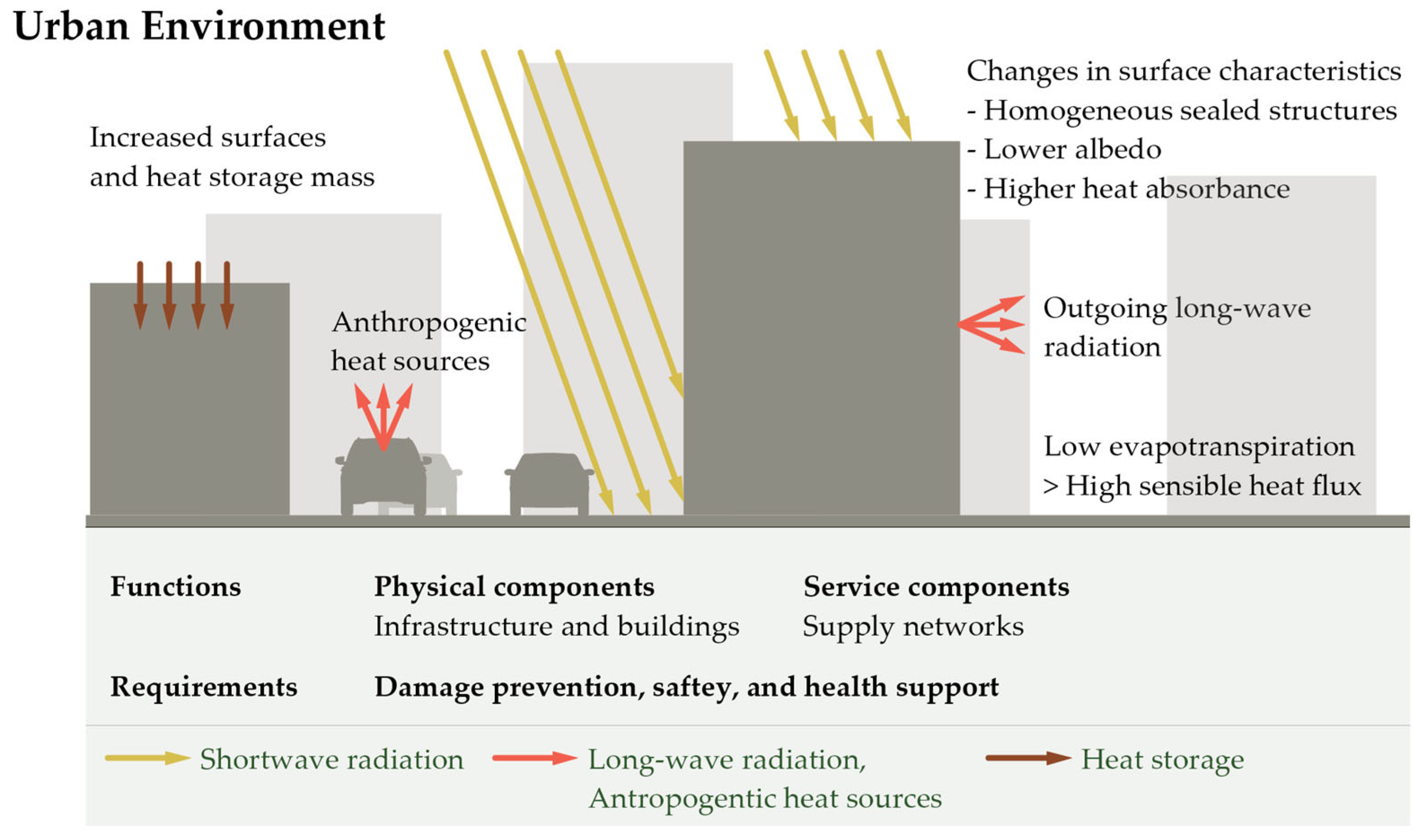
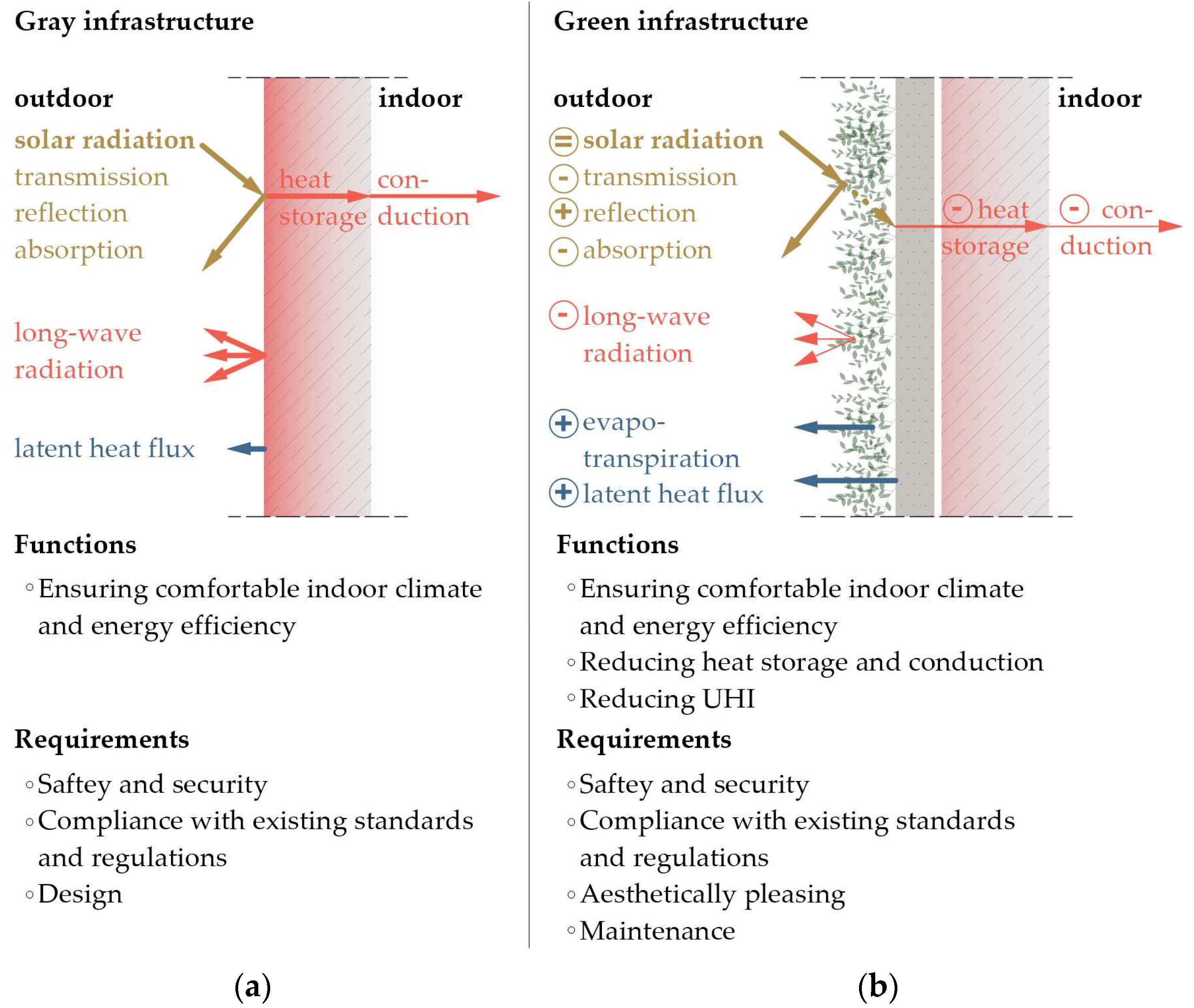
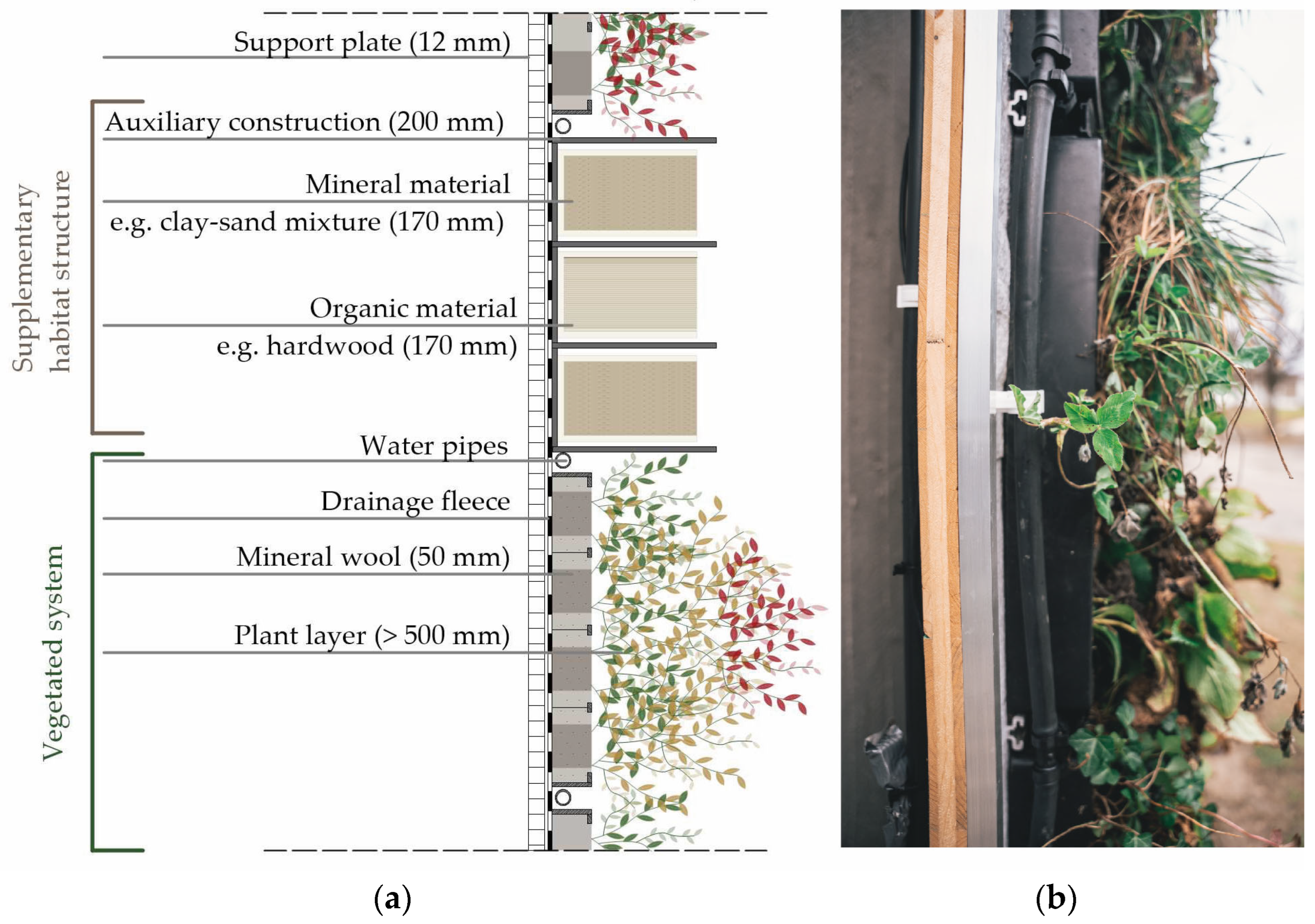
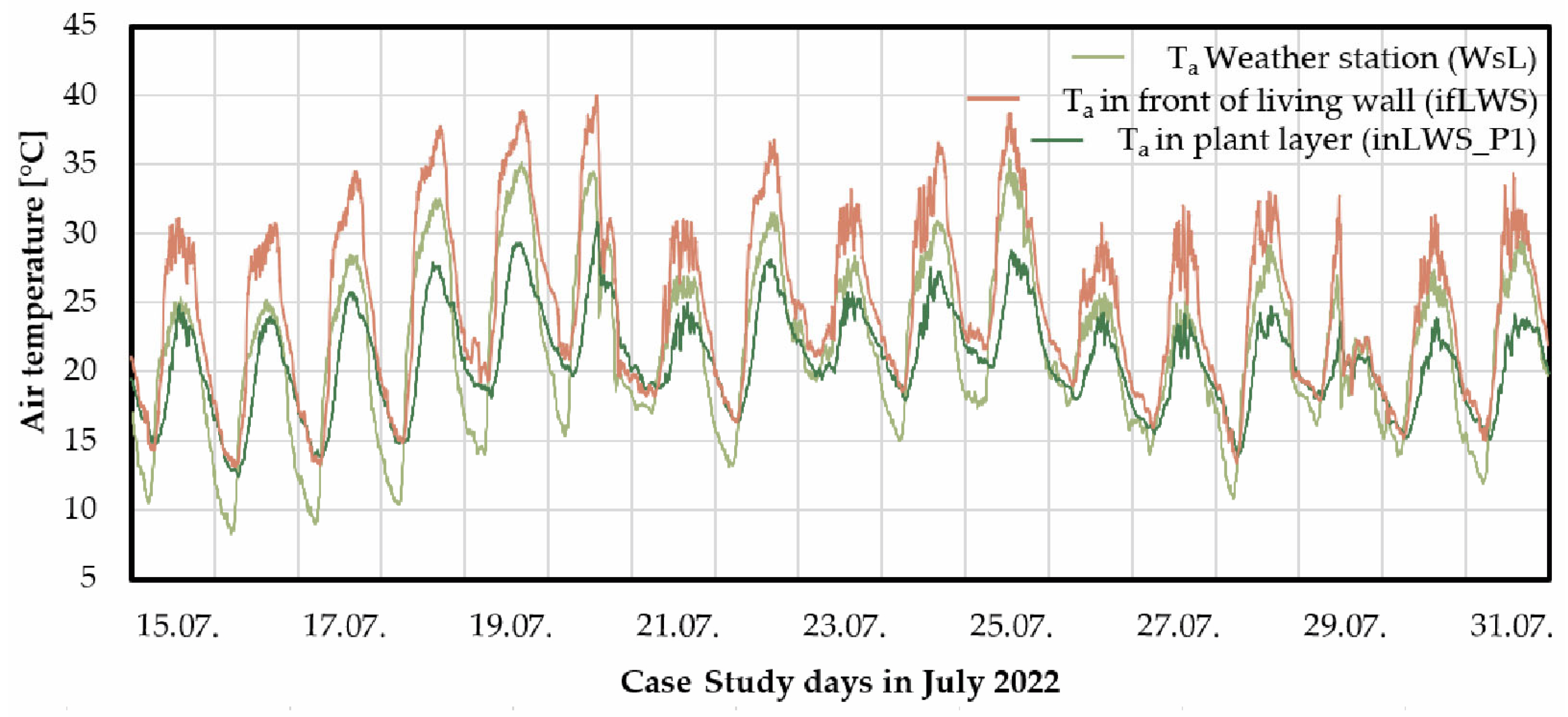
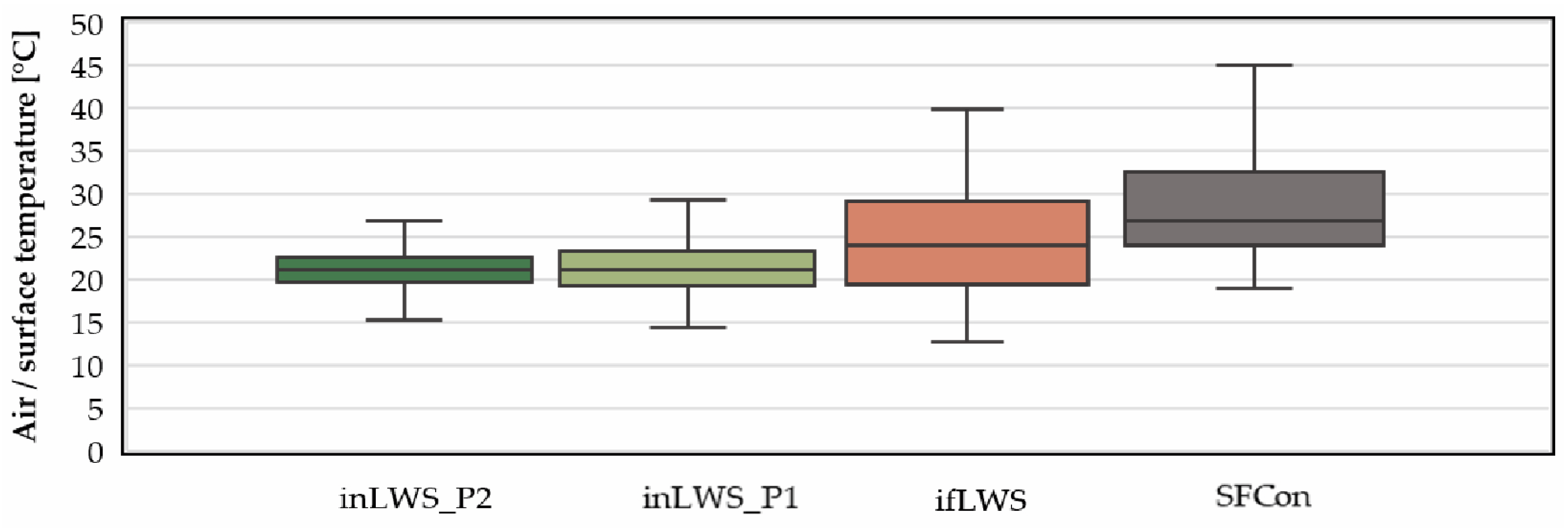
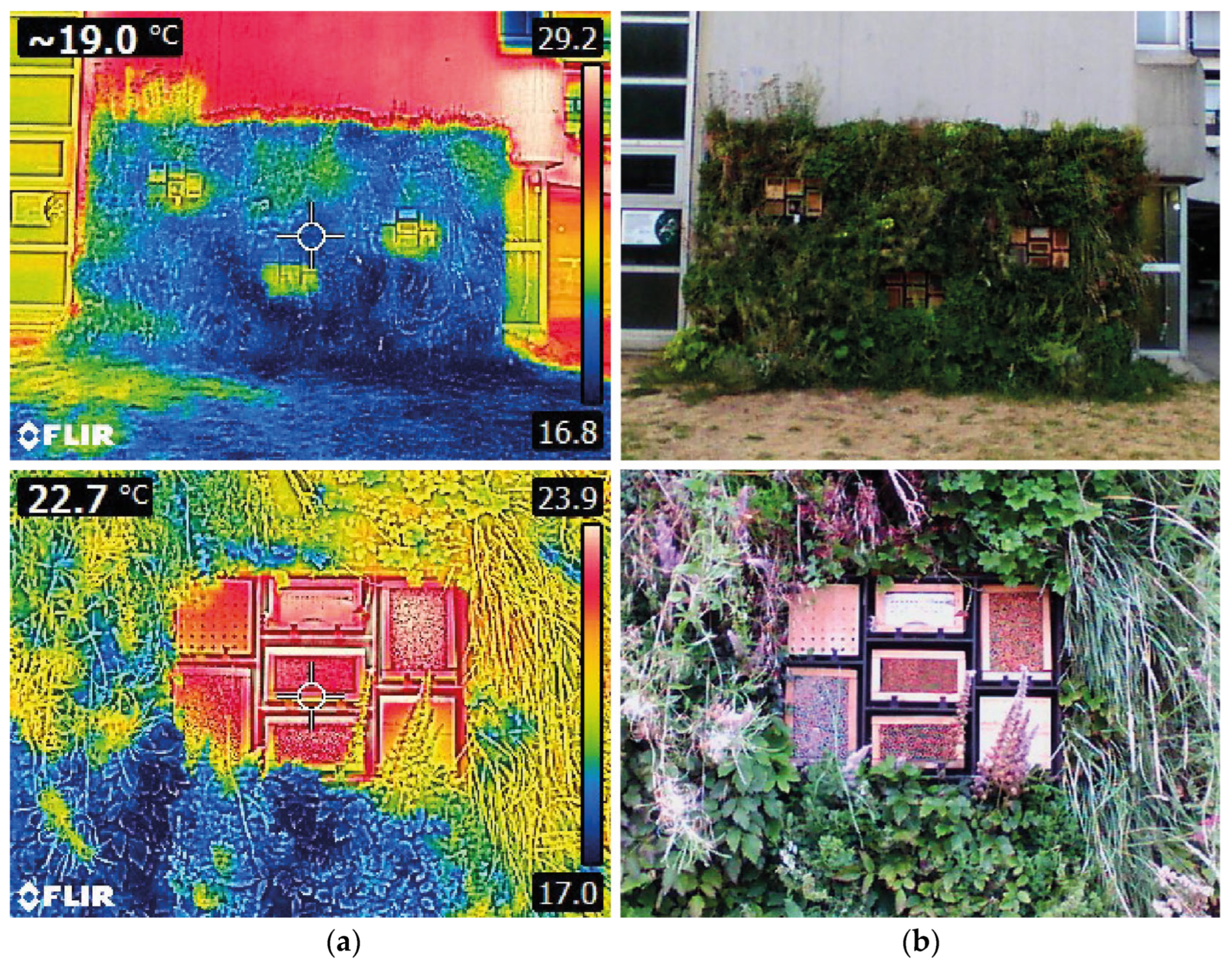


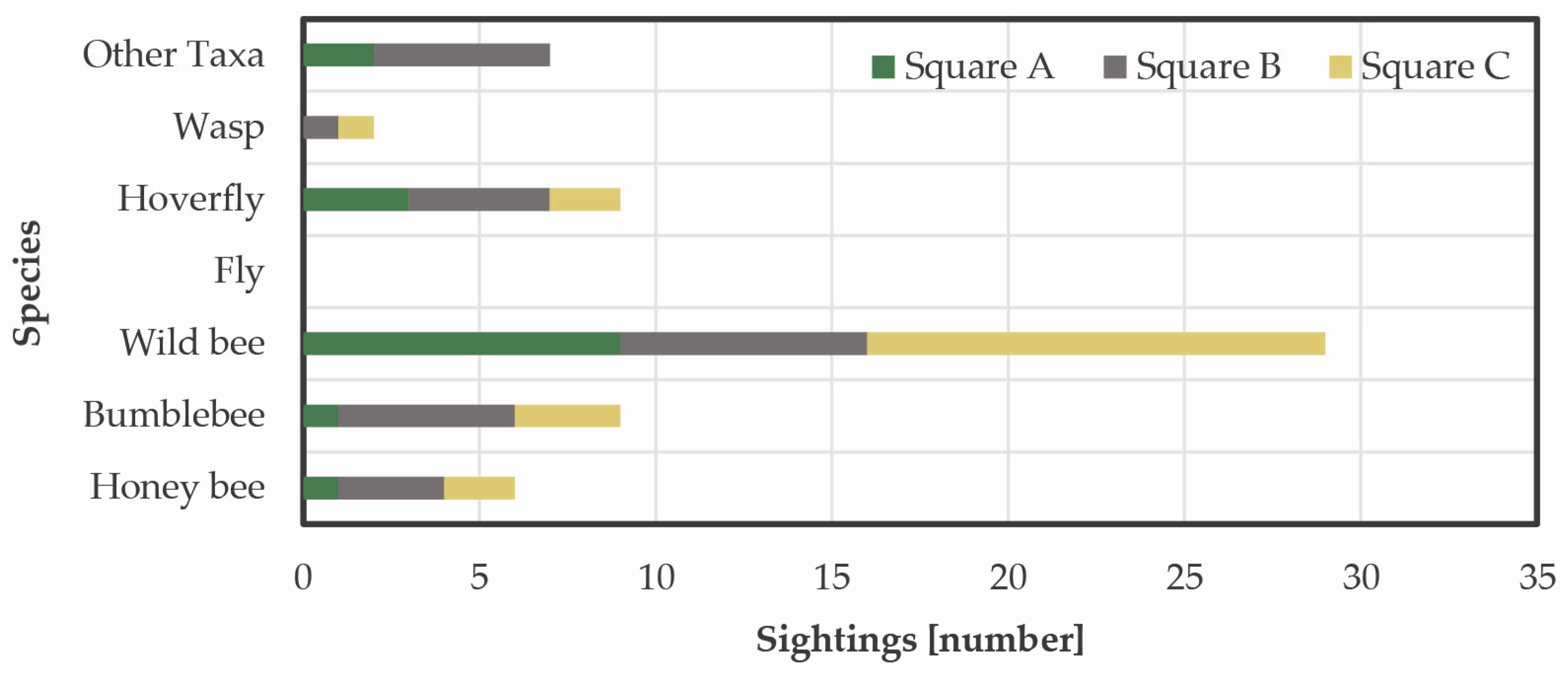

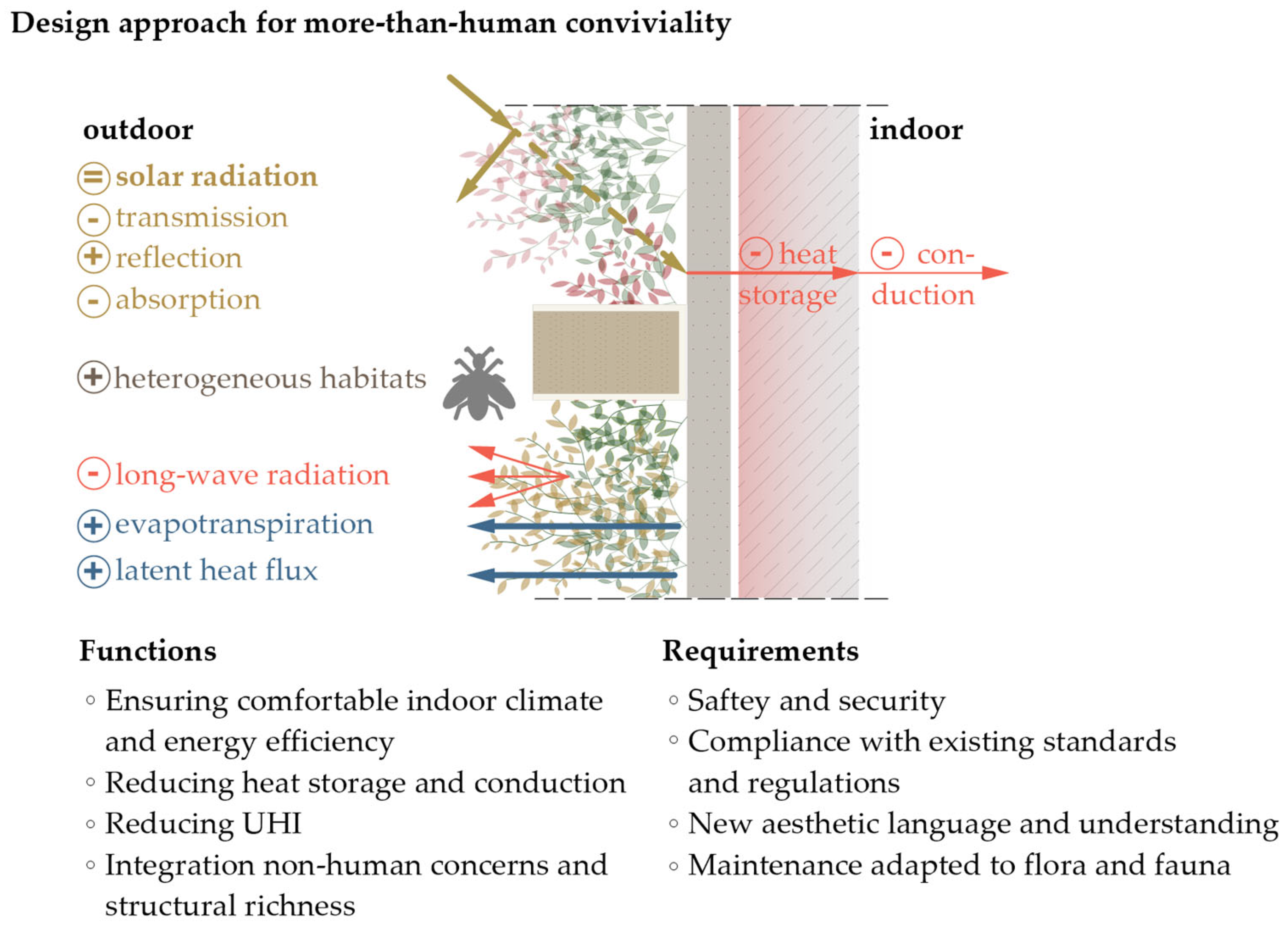
Disclaimer/Publisher’s Note: The statements, opinions and data contained in all publications are solely those of the individual author(s) and contributor(s) and not of MDPI and/or the editor(s). MDPI and/or the editor(s) disclaim responsibility for any injury to people or property resulting from any ideas, methods, instructions or products referred to in the content. |
© 2023 by the authors. Licensee MDPI, Basel, Switzerland. This article is an open access article distributed under the terms and conditions of the Creative Commons Attribution (CC BY) license (https://creativecommons.org/licenses/by/4.0/).
Share and Cite
Bornschlegl, S.; Krause, P.; Kropp, C.; Leistner, P. Analysis of the Microclimatic and Biodiversity-Enhancing Functions of a Living Wall Prototype for More-than-Human Conviviality in Cities. Buildings 2023, 13, 1393. https://doi.org/10.3390/buildings13061393
Bornschlegl S, Krause P, Kropp C, Leistner P. Analysis of the Microclimatic and Biodiversity-Enhancing Functions of a Living Wall Prototype for More-than-Human Conviviality in Cities. Buildings. 2023; 13(6):1393. https://doi.org/10.3390/buildings13061393
Chicago/Turabian StyleBornschlegl, Sebastian, Pia Krause, Cordula Kropp, and Philip Leistner. 2023. "Analysis of the Microclimatic and Biodiversity-Enhancing Functions of a Living Wall Prototype for More-than-Human Conviviality in Cities" Buildings 13, no. 6: 1393. https://doi.org/10.3390/buildings13061393
APA StyleBornschlegl, S., Krause, P., Kropp, C., & Leistner, P. (2023). Analysis of the Microclimatic and Biodiversity-Enhancing Functions of a Living Wall Prototype for More-than-Human Conviviality in Cities. Buildings, 13(6), 1393. https://doi.org/10.3390/buildings13061393







